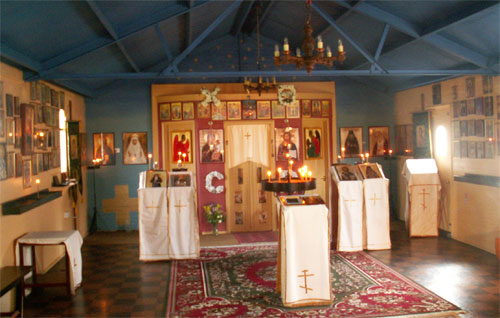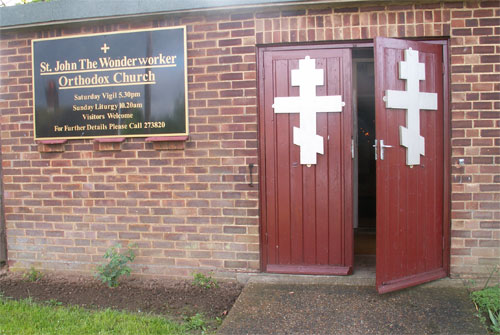SEEK GOD AND YOUR SOUL SHALL LIVE
Psalm 68,33 (Septuagint)
FELIXSTOWE ORTHODOX CHURCH
![]()

St John the Wonderworker Orthodox Church
Wadgate Road,
Felixstowe,
Suffolk,
IP11 2LP,
ENGLAND.
Tel: 01394 273820
-MAP-
e-mail: frandrew_anglorus@yahoo.co.uk
St John the Wonderworker Orthodox Church
Registered Charity No 1081707
It is natural for English Orthodox to wish to see churches established in their home towns and counties. With my own family from the Essex-Suffolk border and my wife's English family originally from Cambridgeshire before going out to the colonies, we wished therefore to help establish something in this area.
Returning to England in 1997, we initially considered setting up a church in Bury St Edmunds. Now, this town is in Suffolk, a county which had no Orthodox presence whatsoever. Moreover, not only is it central to the four Eastern Counties, Essex, Suffolk, Norfolk and Cambridgeshire, but also it is named after the great Pre-Schism Saint Edmund the Martyr who was once the Patron-Saint of England.
However, nothing was positive here and once more we prayed in order to find out what to do. St Edmund sent us to St Felix, the bringer of the Orthodox Faith to East Anglia and the only other Suffolk town named after a Saint, the seaside resort of Felixstowe. After all, the East Anglian Apostle St Felix had like us come as a missionary from France. Here, in this town of thirty thousand, the fourth largest container-port in Europe and twelve miles from the major town of Ipswich, we found everything that we needed and at prices far below those of Bury St Edmunds. God was showing us what to do through His Saints.
Having moved from France in July 1997, we at once established a town-centre chapel. Fr Silvanus of the Greek monastery at Tolleshunt Knights felicitously called this chapel 'the upper room'. In August 1997 the author had the pleasure of serving Orthodox services in his native language for the first time ever after thirteen years as an Orthodox clergyman. Singing was assumed by matushka who had twenty-five years of experience since childhood as choir member and conductor in French and Slavonic. The property rented was adequate for a congregation of 25 - provided they could manage the stairs from the parish room downstairs. By the end of 1998 it was clear that we had to look for other, more suitable, much larger and above all permanent premises.
In September 1999 we discovered that a former church building near Felixstowe town-centre was in fact vacant. This was part of a 1950's complex with a very large hall, warden, wheelchair access, toilets, kitchen and large grassed area. The last service here had been held as long ago as 1991 and since then the building had variously been used as a youth club, a computer club for the unemployed and as a storage-hall.
It was clear that this building was ideal for us. It was an anonymous building, apart from the large cross on the roof, which could be converted into almost anything, including into an Orthodox church. This rectangular, red-brick, hall-like structure, 1,200 square feet in size, and situated on a housing estate near the town-centre, would require relatively little major work to convert into an Orthodox church. Its adjoining facilities, with hall, kitchen and toilets, would be most useful.
After six months of complex and bureaucratic negotiations, we finally received the keys to the church early in April 2000. After three weeks of conversion work, Orthodox services started in this church, aptly enough, with the Vigil for Palm Sunday (the Entrance into Jerusalem) 2000. Eventually we decide to dedicated the church to St John the Wonderworker (+ 1966), formerly our Archbishop in London.
Work to make the Orthodox Christianity better known here continues. Since 1997, lives of St Edmund and St Felix have been written and of course icons painted. In particular, the booklet on the life of St Felix, Apostle of East Anglia, has sold well throughout Suffolk. Publicity has also included a short article in 'The Times' in 1999 and a television programme on English national identity featuring our church and shown nationwide on Channel Four in January 2000. Chaplaincies at Ipswich General Hospital and the local Suffolk College have been established. Contacts have been made with the tiny numbers of local immigrants from Greece, Cyprus, Russia, Romania, the Ukraine and Serbia (Suffolk is not an area of immigration).
Through the Yellow Pages an Advisory Service, suitably known as OASIS (Orthodox Church Advisory Service in Suffolk) has been established. Several talks about the Orthodox Church have been given to a wide variety of churches, organizations and societies. An 'open day' took place in September 2000, when many were able to visit the church; other such days and coffee mornings are planned in order to reach out to local people. An annual fund-raising church bazaar has been established since 1998. Importantly, friendly contacts have been made with Felixstowe Town Hall and the Mayor. Here, it has been suggested that the English North Sea port of Felixstowe be twinned with the Russian Black Sea port of Novorossisk, where the author spent some time in summer 1976, making useful contacts with Russian Orthodox there.
With congregations of up to one hundred and twenty, we are now looking forward to further expansion in the coming years. In this connection we had a number of projects in mind for the 2001 Millennium Year, which is also the fiftieth anniversary of the building of our church:
Firstly, there was the establishment of this website with the kind and indispensable help of a local Orthodox layman, David Davies from Ipswich. Secondly, there is the project to obtain a peal of five bells from Russia. It is a cherished idea to think of the town and port of Felixstowe, the town of St Felix, echoing to the ringing of Orthodox bells on Saturdays, Sundays and Orthodox holy days. Thirdly, we prepared a small brochure for the Jubilee of the church (1951-2001) and this brought additional publicity, leading people to visit the church. And finally we established the 'Felixstowe Orthodox Church' charitable trust (registered with the Charity Commissioners).
As we enter the twenty-first century, we Orthodox may feel that the time is ours. However, we remain cautious and sober. We are very conscious that none of our hopes and prayers for the future will be realized unless we obey God in all we do.

ST
JOHN THE WONDERWORKER ORTHODOX CHURCH, FELIXSTOWE
Registered Charity No 1081707
St John's Orthodox Church welcomes you to its services. We are members of the local diocese of the Orthodox Church Outside Russia. Although Russian in origin, this branch of the Orthodox Church is administratively quite independent of the Church in Russia, our services are in English.
The Sunday service is called the Divine Liturgy. It is the communion service, as used all over the Orthodox world and it recreates the Life of Christ. Preceded by brief readings, the Liturgy lasts just over one hour. In keeping with ancient Christian Tradition, Orthodox Christians stand throughout it and participate in it by praying with its words, crossing ourselves and singing. Please do come up to the front of the church and follow the service. Feel free to sit down but if you wish to participate, please stand at the two Entrances, during the Gospel reading and during the Eucharistic Canon. If you feel confident enough to come over and join in the singing, you would be most welcome.
The Liturgy begins with the words, 'Blessed is the Kingdom. . . '. This is followed by the great litany ('In peace let us pray to the Lord . . . '), which is followed by a sung psalm, then the little litany ('Again and again, in peace let us pray to the Lord'), then another sung psalm, then the little litany once more. Then are sung the Beatitudes and there follows the Little Entrance, when the priest leaves the altar and brings the Gospel-Book into the nave. This represents the beginning of Our Lord's public preaching.
This is followed by the singing of the hymns of the day, the Thrice-Holy hymn, the Gradual and the Epistle. Next come the Alleluia and the Gospel reading, which is followed by four short litanies. Then the choir sings the Cherubic Hymn and the Great Entrance takes place. This is when the priest leaves the altar with the chalice and paten and commemorates our bishops, the civil authorities and those gathered here. This represents Christ's Entrance into Jerusalem and the events which led to His Crucifixion and Resurrection.
After another litany, we sing the Creed in its original fourth-century form (the Orthodox Church is the only Church to do so) and there begins the Eucharistic Canon ('It is meet and right . . . '), when bread and wine are offered up and consecrated, the Holy Spirit changing them into the Body and Blood of Christ. This is followed by a litany, the singing of 'Our Father', the priest's communion and the communion of Orthodox Christians who have prepared. This represents our spiritual resurrection with the Risen Christ. At the end of the service all are blessed with the chalice raised on high - representing Christ's Ascension - and then we sing a hymn of Pentecost to the Holy Spirit. This is followed by the sermon. At the end of the liturgy Orthodox and Non-Orthodox alike come up to kiss the cross and take a small piece of blessed bread.
If you would like any further information, please contact me on (01394) 273820.
Fr Andrew Phillips
FOR CHILDREN
The Orthodox Church is the oldest Christian Church. Its centre is in Jerusalem where Jesus Christ died and rose from the dead.
Members of the Orthodox Church are called Orthodox Christians. There are some 200 million Orthodox Christians all over the world and some 200,000 in England.
Orthodox Christians still worship like the early Christians. There are no seats or organs and the Orthodox Church keeps the special early Christian calendar. During the services people sing songs, or hymns, and people pray, that is they talk to God. They light candles and the church smells very nice because of a perfume which is called incense. The priest wears a beard and special clothes, so that he resembles Christ. In ordinary churches, outside the monasteries, the priest is married and his wife plays an important part in church life.
The priest leads the service from the sanctuary. This is a special place behind a screen. This screen and the walls of Orthodox churches are covered with special pictures, or icons, of Christ, the Saints and the Angels. Some of the Saints, or holy people, lived a long time ago, others lived very recently and some of us knew them. They make our Church into one big family because they pray for us and help us when we are in trouble. After the services everybody eats and drinks together in the church hall next to the church.
The most important feast in the Orthodox Church is Easter when there is a special service at midnight. The priest shouts 'Christ is Risen!' to everyone in church and the people shout back, 'He is Risen Indeed!'. Everywhere is decorated with the letters 'CR', that means 'Christ is Risen'.
Our
Orthodox church in Felixstowe is in Wadgate Road. It is called St John's,
who was our Archbishop in London, but we also remember two local people,
St Felix and St Edmund. Although they lived a long time ago, we still
remember them because they were very great Orthodox Christians. In fact
the Suffolk towns of Felixstowe and Bury St Edmunds are named after them.

The Felixstowe Mother of God